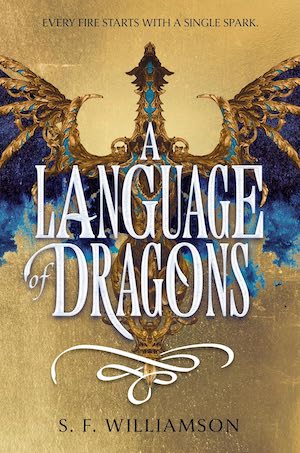The marketing copy for S.F. Williamson’s A Language of Dragons describes it as Babel meets Fourth Wing. It’s understandable why it’s described as such (beyond, of course, these books’ commercial success): The story’s main character is a linguist (like Babel, though in this case, dragon languages) and the book takes place in a grim world where there’s a strict caste system for humans and dragons exist as an integral part of society (like Fourth Wing).
But where those books are clearly for adult readers, A Language of Dragons is solidly a young adult novel. It takes place in an alternate history of 1920s England, where Viv Featherswallow is a student in the middle tier of the country’s rigid caste system who strives to become a renowned dragon scholar. Her idea of the world and her place in it is shattered when Stormtrooper-esque authorities arrest her parents and her cousin, Marquis, for being part of a resistance fomenting against the government, leaving her and her five-year-old sister on their own.
Desperate to save her parents, Viv turns immediately against the system she’s followed her whole life and frees Chumana, an imprisoned dragon forced to work at a local library, under the condition that she burns down 10 Downing Street and the evidence against her parents within it. (As a reader, it’s probably best not to dwell on how quickly she decides to break the rules she’s lived in fear of her entire life, and how she thinks this scheme would work.) Chumana fulfills her end of the bargain, civil war breaks out, and Viv gets arrested. The prime minister, however, decides to have her work on a secret project: Dragons use a secret code via echolocation, she tells Viv, and she wants the teenager and her polyglot abilities to be part of the team set to crack it. Viv agrees, provided her cousin Marquis goes with her and that, if she succeeds, her entire family will be pardoned.
The bulk of the story takes place at Bletchley Park, a secret compound for England’s authoritarian government. It’s there she meets fellow teenage researchers forced to work on various projects to win the war against the rebels. She has romantic sparks with one of those other students, a Third Class boy named Atlas who can’t seem to stupidly stop mouthing off to his captors, an act that seems to accomplish nothing other than having him sent to solitary for a day or so rather than executed. (It’s also hard to see how Atlas falls so hard for Viv beyond general physical attraction—made all the more titillating given he’s in training to be a priest! They are teenagers, however, so let’s go with it.)
Buy the Book


A Language of Dragons
Viv has a lot to deal with at Bletchley. There’s the ongoing puzzle of the dragons’ secret echolocation, a mystery that’s arguably the most interesting and intriguing part of the book, not only because of Viv’s sleuthing to understand what it is, but also what it means for dragon culture and, by extension, their relationship with humans. Viv also has some personal demons to sort out, and a major component of A Language of Dragons is Viv’s journey as a character. She is, like all of us, a flawed individual. In her case, she has fully bought into the status quo of the caste system, and—in her effort to keep her status, betrayed her best friend, Sophie, who is demoted to Third Class, people who have little to no resources or rights. Part of Viv’s journey is realizing that although she’s done awful things, she’s not an awful person; she can change and do what she can to rectify her past mistakes.
To that end, a lot of page space is dedicated to others, particularly Atlas and Marquis, trying to convince her that she should turn away from the dark side represented by the prime minister, join the rebellion, and try to forgive herself for betraying her best friend. Indeed, some of her conversations with Atlas and Marquis can feel more like a treatise than a one-on-one conversation with someone dear.
Perhaps the heavy-handed approach is tempered by the younger audience A Language of Dragons is targeted towards. Young adult books, of course, don’t need to be this way—Rachel Hartman’s Tess of the Road, for example, deals with similar themes with deft subtleness—but there’s arguably more leeway. And while some may say that Viv is too unlikeable given her resistance to realizing that the current regime is, in a word, evil, I don’t think that’s a flaw of the book. Characters who aren’t perfect make for more interesting reading. A great recent example of this is Emily Tesh’s Some Desperate Glory, which has a similar main character in that they both don’t initially see the inherent problems with the society they’re enmeshed in. You don’t have to love Viv to understand her, and while her motivations and her journey in coming to terms with her past actions and beliefs were ham-fisted at times, it still sends a worthy message to readers. What’s less strong are the characters around Viv, who often serve as scaffolding to support certain themes or messages rather than be fully realized individuals in their own right.
A Language of Dragons is a fine read for those who love worldbuilding and crave a dark, alternative history full of dragons with enough action and intrigue via the clash between the government and the resistance to satisfy those who need a compelling plot. Viv uncovering the meaning of the dragons’ secret language holds your attention, and the end answers enough questions while leaving open the potential for more stories in this world. But readers who lean toward novels that are a bit subtler with their themes or characters who are fully fleshed out and complex might not be eager to pick up a potential sequel.
A Language of Dragons is published by HarperCollins.

